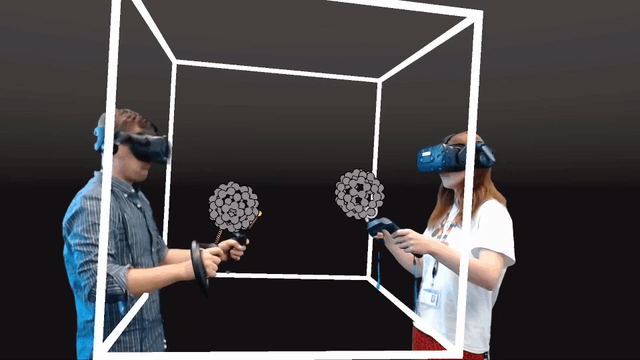touching molecular physics
It is a fundamental human instinct to build both conceptual and tangible models that help to organize and make sense of our perceptions and experience in the natural world. The practice of building and manipulating models has a rich history and profound impacts across a range of domains, including the physical sciences, the social sciences, engineering, medicine, design, and architecture. From a modeling perspective, domains like the nanoscale are interesting, because the objects of study (for example, molecules) are invisible to the naked eye, and their behavior is governed by physical forces and interactions significantly different from those forces and interactions that we encounter during our day-to-day phenomenological experience. In domains like this, which are imperceptible to the naked eye, effective models are vital to provide the insight required to make research progress.
As molecular scientists have made progress in their ability to engineer nanoscale molecular structure, we face new challenges in our ability to engineer molecular dynamics (MD) and flexibility.
Dynamics at the molecular scale differs from the familiar mechanics of everyday objects because it involves a complicated, highly correlated, and three-dimensional many-body dynamical choreography which is often nonintuitive even for highly trained researchers. Over the years, we have pioneered an approach which we refer to as “Interactive molecular dynamics in virtual reality” (iMD-VR) which enables researchers to simultaneously cohabit real-time simulation environments to interactively visualize and manipulate real-time MD simulations of flexible molecular structures with atomic-level precision.
We first outlined this approach in an open access Science Advances paper published during summer 2018, entitled “Sampling molecular conformations and dynamics in a multiuser virtual reality framework”. This generated significant media exposure, having been picked up by a number of scientific media outlets, including for example Nature, the New York Times, and the BBC’s “Science in Action” show (the VR piece begins 7 mins in). It’s been exciting to witness the interest which this work has generated. It certainly seems to be an approach which captivates people’s imaginations.
PUBLICATIONS
M. O Connor, H. M. Deeks, E. Dawn, O. Metatla, A. Roudaut, M. Sutton, B. R. Glowacki, L. M. Thomas, R. Sage, P. Tew, M. Wonnacott, P. Bates, A. J. Mulholland, D. R. Glowacki, “Sampling molecular conformations and dynamics in a multi-user virtual reality framework”, Science Advances 4(6), doi:10.1126/sciadv.aat2731, 2018
R. J. Shannon, H. M. Deeks, E. Burfoot, E. Clark, A. J. Jones, A. J. Mulholland, D. R. Glowacki, “Exploring human-guided strategies for reaction network exploration: Interactive molecular dynamics in virtual reality as a tool for citizen scientists”, J. Chemical Physics, 155, 154106 (2021); doi: 10.1063/5.0062517
Interactive molecular dynamics from quantum chemistry to drug binding: an open-source multi-person virtual reality framework M. O’Connor, S.J. Bennie, H.M. Deeks, A. Jamieson-Binnie, A.J. Jones, R.J. Shannon, R. Walters, T. Mitchell, A.J. Mulholland, D.R. Glowacki. J. Chem Phys 150, 224703 (2019)
Narupa iMD: A VR-Enabled Multiplayer Framework for Streaming Interactive Molecular Simulations Jamieson-Binnie, A. D., O’Connor, M. B., Barnoud, J., Wonnacott, M. D., Bennie, S. J., & Glowacki, D. R. (2020, August 17). ACM SIGGRAPH 2020 Immersive Pavilion. SIGGRAPH ’20: Special Interest Group on Computer Graphics and Interactive Techniques Conference. https://doi.org/10.1145/3388536.3407891

